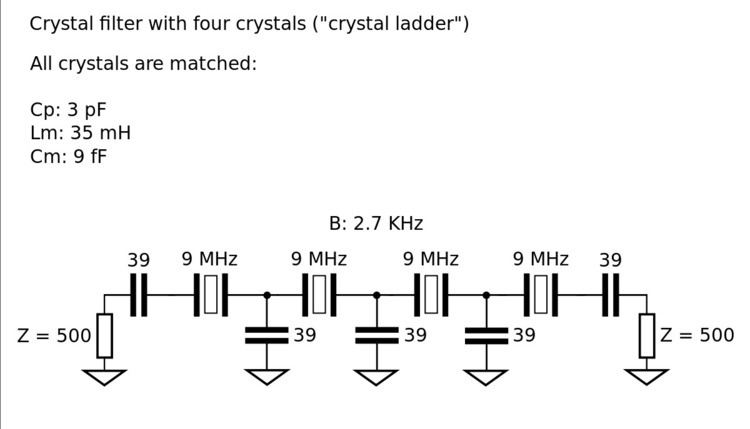 | ||
A crystal filter is an electronic filter that uses quartz crystals for resonators. Quartz crystals are piezoelectric, so their mechanical characteristics can affect electronic circuits. (see mechanical filter) In particular, quartz crystals can exhibit mechanical resonances with a very high Q factor (from 10,000 to 100,000 and greater — far higher than conventional resonators built from inductors and capacitors). The crystal's stability and its high Q factor allow crystal filters to have precise center frequencies and steep band-pass characteristics. Typical crystal filter attenuation in the band-pass is approximately 2-3dB. Crystal filters are commonly used in communication devices such as radio receivers.
A crystal filter is very often found in the intermediate frequency (IF) stages of high-quality radio receivers. Cheaper sets may use ceramic filters built from ceramic resonators (which also exploit the piezoelectric effect), or tuned LC circuits. The use of a fixed IF stage frequency allows a crystal filter to be used because it has a very precise fixed frequency. Very high quality IF filters, called crystal ladder filters, can be constructed by using serial arrays of crystals.
The most common use of crystal filters are at frequencies of 9 MHz or 10.7 MHz to provide selectivity in communications receivers, or at higher frequencies as a roofing filter in receivers using up-conversion. The cut of the quartz crystal determines the crystal's vibrating frequencies, such as the common AT cut used for crystal filters designed for radio communications. The cut of the quartz also determines certain temperature characteristics of the component, of which quartz has a very high temperature stability.
Ceramic filters tend to be used at 10.7 MHz to provide selectivity in broadcast FM receivers, or at a lower frequency (455 kHz) as the second intermediate frequency filters in a communication receiver. Ceramic filters at 455 kHz can achieve similar bandwidths to crystal filters at 10.7 MHz.
The design concept for utilizing quartz crystals as a filtering component was first established by Walter Cady in 1922, but it was largely Walter Mason's work in the late 1920s and early 1930s that devised methods for incorporating crystals into LC lattice filter networks which set the groundwork for much of the progress in telephone communications. Crystal filter designs from the 1960s allowed for true Chebyshev, Butterworth, and other typical filter characteristics. Crystal filter design continued to improve in the 1970s and 1980s with the development of multi-pole monolithic filters, widely used today to provide IF selectivity in communication receivers. Crystal filters can be found today in radio communications, telecommunications, signal generation, and GPS devices.
